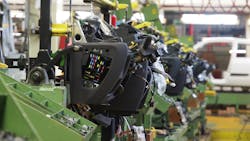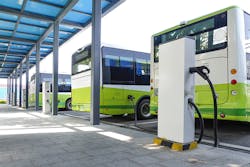Automotive Industry Accelerates to an Electrified Future
This article is part of the TechXchange: EV Battery Management
What you’ll learn:
- How battery innovation (e.g., solid-state batteries) may change the landscape in relation to range, lifespan, efficiency, acceleration, and charging-speed capabilities.
- What technologies are being evaluated in the market to improve the energy capacity of batteries?
- Important tests and measurements to evaluate the performance of powertrain and battery components.
The regulatory push to reach net-zero emissions and increased customer preference for electric vehicles (EVs) has resulted in 18 of the 20 largest auto-manufacturing OEMs in the world committing to increase their EV sales and offerings, according to the IEA. With an infusion of upwards of $200 billion of new investments in the next five to 10 years, these OEMs are focusing on three trending areas: electrification and batteries, the connected car, and next-gen autonomous vehicles.
Successfully moving the market to a point where EVs are accessible to everyone will require the ability to quickly evaluate, test, and analyze components and systems from the lab to the field during the design process.
These trends, the innovations around them, and their unique testing challenges and solutions are what will “drive” the market into the future. Everything from how automakers are structured, financed, and go to market was optimized around the traditional internal combustion engine (ICE). But this competence is shifting, and automakers are transitioning from ICEs to powertrain and batteries. The century-long reign of the ICE powertrain has an expiration date now.
Of these three key areas, a number of emerging innovations and market trends are focused on solving some of today’s lithium-ion battery challenges. Battery demand has gone through the roof as customers have embraced EVs.
According to McKinsey, the battery market is estimated to grow at about 30% (CAGR) between now and 2030, reaching about 4,000-GWh capacity, which is equivalent to about 90 additional gigafactories. Today, China is responsible for the lion’s share of production for lithium-ion batteries (see figure). However, battery innovation such as the solid-state battery may change this landscape.
Lithium-Ion vs. Solid-State Batteries
Using lithium-ion batteries in cars is trending today, but these batteries have performance issues in relation to range, lifespan, efficiency, acceleration, and charging-speed capabilities. The ions in lithium batteries move through liquid, making them heavier, which negatively impacts range.
Thus, automakers are looking to shift toward solid-state batteries, which use solid material—they reduce weight and in turn improve the vehicle’s range. Another advantage to solid-state batteries is they have a higher energy density. The more dense the battery, the longer the range it can extract on a single charge.
Going the Distance
As OEMs research ways to improve battery performance, the two factors of utmost importance are: how far can an electric car go on a single charge, and how long does the battery last?
One way to improve distance and duration is to increase the number of battery cells per battery pack in a vehicle. However, this isn’t an optimal solution because both the vehicle’s price and its weight will rise. To extend the range of a battery on a single charge, the energy capacity must be increased. The industry is examining a few different ways to accomplish this goal:
- Increase the battery energy density measured in watt per hour (W/hr). This is the path the industry is pursuing today. Since the introduction of lithium-ion, its specific energy has gone up at 6% CAGR year-over-year since 1991. This is lower than the energy density of regular gas that we put in our traditional vehicles today by a factor of a 100. So, there’s lots of room to improve.
- Remove modules from the “cell to module to pack” order by skipping the module. Going directly from cell- to pack-level reduces the weight of the vehicle, thereby improving the range of the vehicle on a single charge. However, this introduces thermal conditions and connections, requiring additional wiring.
- Improve efficient energy conversion from dc in battery packs to ac traction motors in EVs. Traction-motor conversion efficiencies improve the process of converting energy stored on the battery pack in dc into energy that physically moves a vehicle forward.
Much more work is needed in relation to battery life. Some of the drawbacks of lithium-ion batteries is they tend to overheat and get easily damaged at very high voltages. In some cases, they can lead to thermal runaways and combustion. Over the lifetime of the battery, the energy storage capacity diminishes. The hope is when we switch to solid-state batteries, some of those lithium-ion tradeoffs will no longer be a concern.
Measurement Challenges: Testing for Safety, Efficiency, and Power
Manufacturers rely on accurate test and measurement tools to evaluate the performance of powertrain and battery components. The power and efficiency of an electric motor represent decisive variables for evaluating and interacting with the battery storage. They also determine the mileage and range of the electric vehicle.
On the powertrain side, certain measurements such as mechanical power, DQ0 measurements (inverter control logic), as well as electrical measurements are very important for evaluating the overall system efficiency of traction inverters. On the battery side, manufacturers are focused on improving the lifetime of the battery while reducing the charge time and increasing energy densities (W/hr).
Different sets and test methods are developed for cell-, module-, and system-level testing. The same instruments that are used at a cell level can be used at a system level. Some examples of common measurements from the battery test perspective include internal resistance measurement.
A dc measurement, open circuit voltage (OCV) measures the voltage at the terminals of the battery after some relaxation time. OCV is one of the key ways to characterize the lithium-ion battery used in automotive applications today. Other measurements are leakage current and charge and discharge pulsing, among others.
At a battery-pack level, certain tests are more important than others, particularly around busbar welding. When batteries are assembled, an incorrect weld can generate excessive heat, which may result in under performance or even battery failure. There are also temperature and environmental tests, self-discharge tests, and battery-management-system (BMS) tests. BMS is an intelligent system that sits and monitors the state of charge (SOC) and state of health (SOH) of the EV battery pack. Many tests and standardizations are needed to improve how far the electric car can travel, and maybe in the future how far urban air taxis will travel.
EV automotive testing now requires manufacturers to test vehicle performance in ever-more demanding environments, such as locations with extreme conditions that are incredibly hot or cold. Tektronix recently introduced an entry-level benchtop scope that goes everywhere it’s needed, from lab to field, without compromising functionality.
Presented by the company as the first of its type, the 2 Series Mixed Signal Oscilloscope is a portable, lightweight scope designed to simplify the work that must be done by engineers across various verticals and testing locations. With field testing becoming more essential and engineering teams often located around the world, natively integrated software tools allow engineers to collaborate, troubleshoot, and debug designs across time zones.
Summary
To grow the EV market substantially, advances in battery technology alone will not be sufficient. Government regulations, industry standards, safety and reliability, and ensuring critical data from the in-vehicle network is given priority all will play a role during the continued development of EVs, the connected car, AVs, and even future electric air vehicles. The goal is for EVs with a 350-mile range to be accessible for all. On this front, Tektronix is committed to helping its customers build a sustainable future, where technology is leveraged to make the world a better place.
Read more articles in the TechXchange: EV Battery Management
About the Author
Denis Solomon
Automotive Market Segment Manager, Tektronix Inc.
Denis Solomon is responsible for the automotive solutions business across Tektronix & Keithley portfolios. Prior to joining Tektronix, Denis served in engineering, sales, and product management roles at various technology companies across three continents. He holds a bachelor's degree in computer engineering from University of Rajasthan and an MBA from the University of California.

